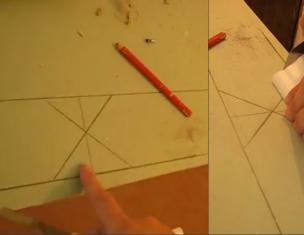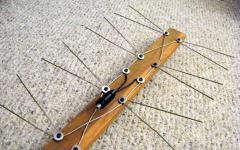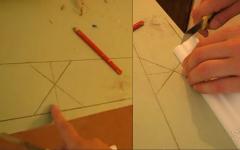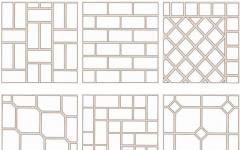Laminate flooring does not cease to be popular in the practice of apartment renovation. This is explained, first of all, by the affordable prices for this material when compared with alternatives of equal quality. Of no less importance is the availability of the technology itself for the correct laying of the laminate, which makes it possible to cope with this task even for a home craftsman with minimal skills in finishing work. From our article you will learn how to properly lay your own laminate flooring.
Here you will find step-by-step instructions for installing your laminate flooring. In order not to urgently search for missing materials during the work, it is worth worrying about the availability of a set for laying laminate in advance:
- the laminate itself;
- primer;
- laminate staples;
- a roll of plastic wrap;
- underlay for laminate;
- Mounting wedges (store-bought or homemade from laminate scraps or wooden pegs);
- skirting boards and fixings for them.
In addition, a special tensioner for laminate panels with a tape length of at least 30 cm will not be superfluous.
As a substrate, you can use extruded polystyrene foam, or bitumen-cork substrate. The first option is interesting for its low cost and durability, the second - for the ability to create a "breathable" substrate and reduce the quality requirements for the subfloor.
In order not to be mistaken with the amount of laminate, the easiest way is to immediately provide a stock of one fifth of the calculated laying area when buying it. Excess material may be required to correct defects in your own work or when laying laminate around communications and other complex elements. You should also find out in advance the area of the panels in one package, since for different options there may be different geometric dimensions and the number of panels in a pack. To prepare the laminate for work, after purchasing it is worth keeping it indoors for a day or two. During this time, the moisture content of the laminate will be equal to the humidity in the room, stabilizing the geometry of the panels.
You will also need a tool for laying the laminate:
- a hacksaw with fine teeth or a jigsaw;
- building corner for checking the corners of the joints;
- hammer or wooden mallet for tighter knocking of panels and installation of wedges;
- roulette;
- pencil;
- masking tape;
- wooden bar.
Below are the different ways to lay your laminate flooring.
Self-laying laminate technology step by step
The entire procedure for laying the laminate can be divided into several stages, performed in a strict sequence.
1. Leveling the subfloor.
Due to the structural and physical properties of the laminate panels, laying the laminate on uneven floors is strongly discouraged. Therefore, the sub floor will need to be properly prepared:
If the laminate is laid on an old concrete floor, then its surface is carefully restored (exfoliated pieces are removed, the resulting recesses and cracks are filled with a cement-sand mixture, and the resulting result is polished);
Fresh cement screed is treated with a primer that allows you to eliminate dust and get rid of the squeak of laminate panels in the future when various grains of sand, etc., get under it;
The old wooden floor is repaired and, if possible, leveled with fiberboard or plywood sheets;
The new wooden floor is processed with a grinder, simultaneously removing all irregularities.
2. Preparation of a plan for laying the panels.
If you have enough experience of self-laying laminate flooring, it is quite possible to do without such a plan. However, for beginners, a pre-drawn diagram of the room with the location of each of the panels will greatly facilitate the work.
When distributing laminate panels on the diagram, it is worth considering some of the features of its installation:
Joints of panels should not form cruciform seams, i.e. panels in each of the rows should be slightly displaced relative to each other;
If the panel is cut across, then its length should not be less than 30 cm;
The minimum width for cutting lengthwise is 5 cm;
When laying on a wooden floor, the laminate panels should be laid perpendicularly
floorboards.
In addition, it is also worth considering on the plan that the laminate will not reach the walls by about 1 cm (the so-called damper indent).
3. Laying the underlayment under the laminate over the entire area of the room.
So that during the laying of the laminate the substrate does not slide on the floor, does not wrinkle and does not interfere, it should be glued along the seams and edges with masking tape. The backing sheets are stacked only end-to-end.
4. The first row of panels is assembled.
To do this, the ridge of the panel looking at the wall is cut off, and the panels themselves are laid out across the entire width of the room.
5. The second row is docked.
6. The entire resulting structure is firmly pressed against the wall.
Spacer wedges are inserted between the wall and the laminate at a distance of 25–30 cm from each other, providing the necessary gap (not less than 8 mm, but not more than the width of the lower part of the plinth).
7. The entire floor area is laid out consistently.
8. Upon reaching the doorway, the laminate panel is cut between the jambs so that it fits snugly without gaps.
9. If during installation it was not without the use of short cuttings, then they should be glued to the main sheet of the laminate.
10. A plinth is attached to the wall.
Choice of direction. Laying the laminate diagonally.
It is customary to lay laminate flooring in three most common directions.
- along the line of light;
- across the line of light;
- diagonally.
The choice of the option for laying the laminate entirely depends on the tasks set during the repair, however, each method has some peculiarities.
1. Laying along the line of light. This is the most common type of laminate installation, as it does not create shading at the seams between the panels, as a result of which the laminate surface looks better laid.
2. Laying across the line of light. Most often, it is used when the windows in the room are located in a long wall. With slightly higher requirements for work, such a layout allows you to visually make the room wider.
3. Laying diagonally. The advantages of this laminate laying scheme include the possibility of creating original interiors. However, the technology of such laying is more complicated, plus, due to the large percentage of waste, a slightly larger amount of laminate will be required.
The very sequence of work when laying the laminate diagonally differs little from the above. The differences will consist only in the following:
- between opposite corners of the room you need to pull the cord that will act as a beacon;
- lay the panels at an angle of 45 degrees in relation to the walls;
- you need to start work from the corner closest to the window;
- the distance between the joints of panels in adjacent rows should not be less than half a meter.
 Which method of fastening the panels to each other can be used is indicated on the packaging of the laminate. There can be two total of these methods: lock and glue.
Which method of fastening the panels to each other can be used is indicated on the packaging of the laminate. There can be two total of these methods: lock and glue.
The locking method is based on the use of structural elements of the panel: special locks in the form of grooves and ridges of various profiles. Depending on the shape of these nodes, there are two types of locks:
- Lock-locks, for snapping into which it is necessary to connect the grooves and ridges either in the horizontal or in the vertical plane;
- Click-locks, snapped by connecting the panels to each other at the desired angle. This connection is more durable.
The glue method is currently practically not used due to its unreliability. Its essence consists in gluing the ends and long edges of the laminate panels with special glue. Sizing is carried out immediately before laying, after which time is given for the glue to dry.
In general, the process of installing laminate flooring does not cause any particular difficulties. It is only important to adhere to basic rules for laying laminate flooring with your own hands:
- lay the laminate only on the prepared surface;
- draw up a layout diagram in advance;
- follow the recommended sequence of steps and the instructions of the laminate manufacturer.
The result is a perfectly flat, durable and beautiful floor covering.
Laying laminate, video:









